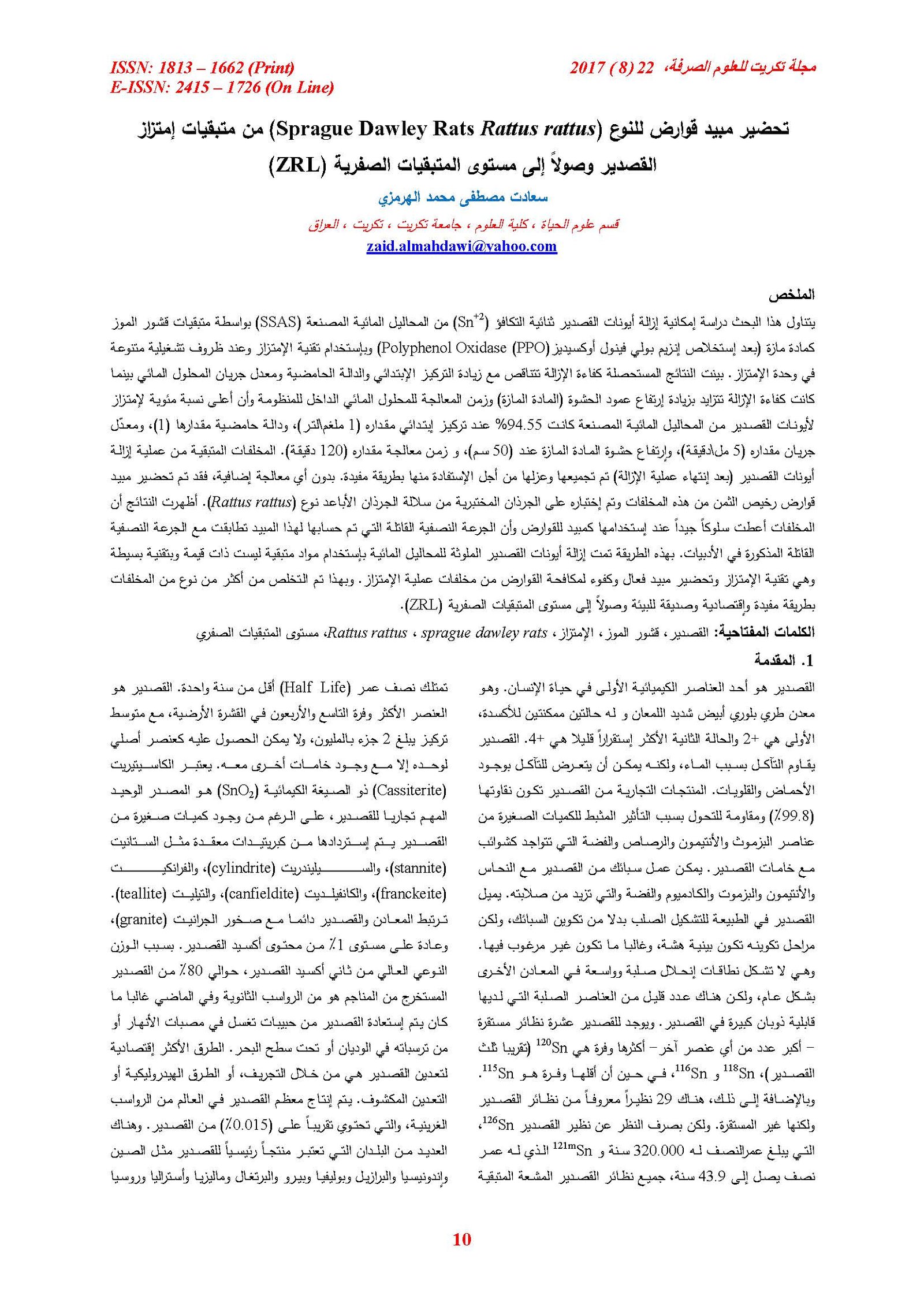Preparation of rodenticide for (Sprague Dawley Rats Rattus rattus) from the residue of tin adsorption arriving to Zero Residue Level (ZRL)
Main Article Content
Abstract
This paper is deal with study the potential of Banana Peel Residue (after extraction of Polyphenol Oxidase (PPO) enzyme) to remove tin (Sn+2) ions from simulated synthesis aqueous solutions (SSAS) through various operating parameters using adsorption technique in sorption unit. Results show that the removal efficiency were 94.55% for tin ions from (SSAS) and the removal efficiency decreased with increasing of initial concentration, pH and SSAS flow rate while the removal efficiency increased with increasing packing height of adsorbent material and treatment time. The waste of banana peel residue (remaining after adsorbed tin) was predestined to investigate the utilization of it in useful method. It can prepare a cheap rodenticide from these BPR waste without any further treatment. The results explain that the BPR adsorb chromium ions showed a good behaviour as rodenticide for sprague dawley rats Rattus rattus. By this way it can perform different benefits which are: remove the chromium ions polluted the water, get rid of agricultural waste banana peel residue, in the same time, prepare a cheap and active rodenticide. It can discard more type of waste in a non-cost and eco-friendly method accessing to zero residue level (ZRL).
Article Details

This work is licensed under a Creative Commons Attribution 4.0 International License.
Tikrit Journal of Pure Science is licensed under the Creative Commons Attribution 4.0 International License, which allows users to copy, create extracts, abstracts, and new works from the article, alter and revise the article, and make commercial use of the article (including reuse and/or resale of the article by commercial entities), provided the user gives appropriate credit (with a link to the formal publication through the relevant DOI), provides a link to the license, indicates if changes were made, and the licensor is not represented as endorsing the use made of the work. The authors hold the copyright for their published work on the Tikrit J. Pure Sci. website, while Tikrit J. Pure Sci. is responsible for appreciate citation of their work, which is released under CC-BY-4.0, enabling the unrestricted use, distribution, and reproduction of an article in any medium, provided that the original work is properly cited.
References
1. Wikipedia:https://en.wikipedia.org/wiki/Tin, 2017
2. Leentech:
http://www.lenntech.com/periodic/elements/sn.htm,
2017
3. World Health Organization (2008), Guidelines for
Drinking-water Quality [electronic resource]:
Incorporating 1st and 2nd ADDENDA, Volume 1.
Recommendations – 3rd ed., ISBN 978 92 4 154761
1 (WEB version), (NLM classification: WA 675).
https://www.epa.gov/foia/third-edition-incorporatingfirst-
and-second-addenda-volume-1-recommendation
4. Radjenovic A. and Medunic G., (2015),
“Adsorptive Removal of Cr(VI) from Aqueous
Solution by Carbon Black”, Journal of Chemical
Technology and Metallurgy, 50, 81-88
5. Barakat M. A., (2011), “New trends in removing
heavy metals from industrial wastewater”, Arabian
Journal of Chemistry, Volume 4, pp:361–377,
doi:10.1016/j.arabjc.2010.07.019
6. Siddiquee S., Rovina K., Al Azad S., Naher L.,
Suryani S. and Chaikaew P., (2015), “Heavy Metal
Contaminants Removal from Wastewater Using the
Potential Filamentous Fungi Biomass: A Review’”,
Microbial & Biochemical Technology, Volume 7,
Issue 6, pp: 384-39, doi:10.4172/1948-5948.1000243
7. Abbas M. N., (2014) “Production of Liquefied
Natural Gas Using Radioactive Waste and
Agricultural Residue”, European Academic Research,
May. Volume II, Issue 2/ ISSN 2286-4822
8. Abbas M. N. and Abbas F. S., (2013), “Iraqi Rice
Husk Potency to Eliminate Toxic Metals from
Aqueous Solutions and Utilization from Process
Residues”, Advances in Environmental Biology,
Volume 7, Number 2, pp: 308-319, ISSN 1995-0756.
9. Abbas M. N. and Abbas F. S., (2014), “A Novel
Method to Recycle the Treated Dye Wastes
Adsorption, Exploitations and No Pollutants
Remain”, LAMBERT Academic Publishing. ISBN-
10: 3848484579; ISBN-13: 9783848484577.
10. Ibrahim. T. A., Abbas, M. N. and Abbas, F. S.,
(2016), “Detoxification of Pesticides Wastewater by
Adsorption Technique Feasibility of Agricultural
Waste Utilization”, LAMBERT Academic
Publishing, ISBN-10: 3659411434; ISBN-13:
9783659-832347
11. Abbas M. N., Husain A. A. and Abbas F. S.,
(2013), “Phenol Removal from Wastewater Using
Rice Husk”, Diyala Journal for Pure Sciences,
October. Volume 9, Number 4, pp:51-60
12. Abbas M. N., (2014), “Phosphorus removal from
wastewater using rice husk and subsequent utilization
of the waste residue”, Desalination and Water
Treatment, Volume 55, Issue 4, pp: 970-977
13. Abbas M. N., (2014), “Converting Banana Peels
from Agricultural Residues to Advantageous
Substances”, Scholars Journal of Engineering and
Technology; Volume 2, Issue 5A, pp:719-726.
14. Abbas M. N., Abbas F. S. and Ibraheem S. A.,
(2014), “Removal of Cyanide Ion from Wastewater
Using Banana Peel and Utilization from Residue”,
Journal of Asian Scientific Research, Volume 4,
Number 5, pp: 239-247.
15. Abbas F. S., (2013), “Thorium removal from
waste water using Banana peel and employment of
Waste Residue”, Advances in Natural and Applied
Sciences, Volume 7, Number 3, pp: 336-344, ISSN
1995-0772
16. Madhavi K. and Saraswathi K., (2104),
“Spectrophotometric Method for the Detection of Tin
(II) in Synthetic Mixtures Using Morpholine
Dithiocarbamate”, International Journal of Emerging
Engineering Research and Technology, Volume 2,
Issue 6, September 2014, pp:163-166. ISSN 2349-
4395 (Print) & ISSN 2349-4409 (Online)
.www.ijeert.org
17. Al-Kattan M. M., Abdul-Fattah J. H. and Al-
Annaz R. M., (2012), “Effect of Salvia Powder on
Blood and Histological Picture of Liver and Heart
Muscle in Male Albino Mice”, Rafidain journal of
science, Volume 23, Number 2A, pp:1-14. (in
Arabic)
18. Safety Data Sheet No.1019 Testkit PO4, OPTEX
CO.,LTD., Ltd. Revise (2015.09.01).
https://www.waterit.optex.net/pdf/1019_05221_WAPO4_
20150901-E(OP).pdf
